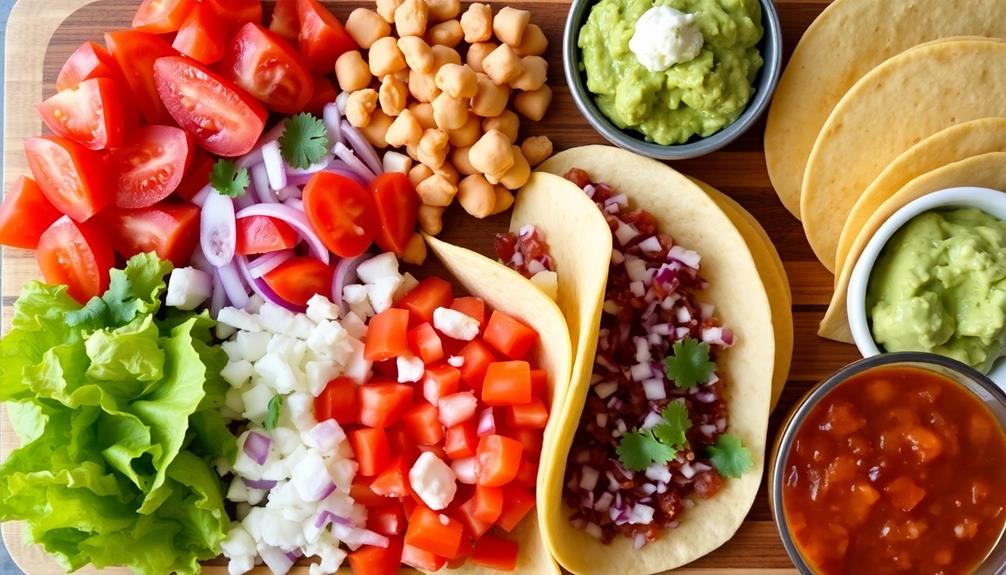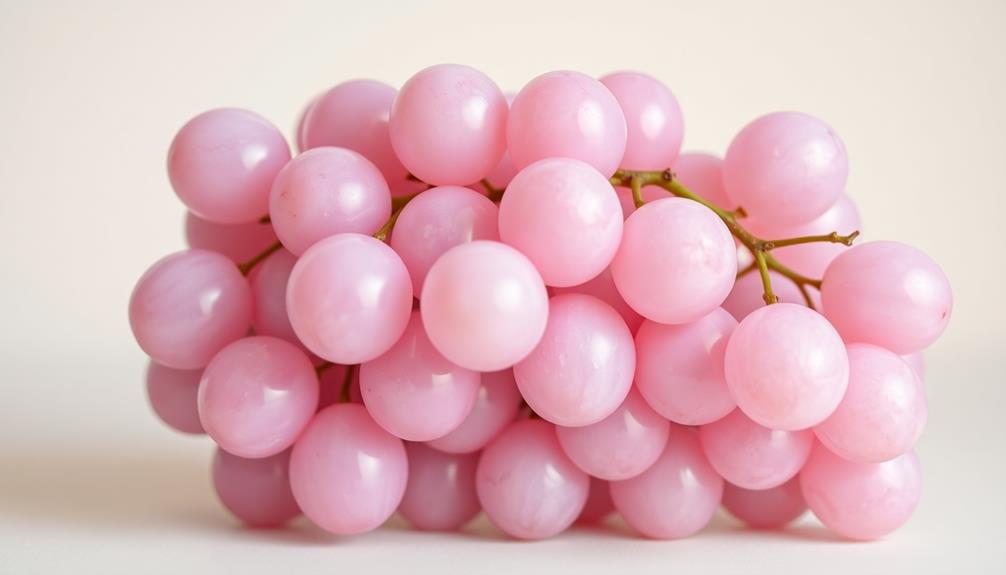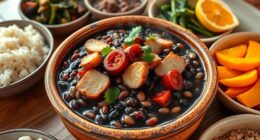Quinoa salad is a vibrant, nourishing dish brimming with ancient superfood quinoa, crisp veggies, and tangy dressing. You'll love how the fluffy quinoa pairs with juicy tomatoes, crunchy cucumbers, and zesty onions. It's naturally gluten-free and packed with protein, fiber, and vitamins – a wholesome meal or side that satisfies. Customize it with your favorite mix-ins like avocado or chickpeas. Quinoa salad's versatility makes it perfect for meal prep, picnics, or quick dinners. With its fresh flavors and easy preparation, you'll want to savor every bite. There's more to discover about this superfood sensation! For a delicious twist on the classic quinoa salad, try adding some Mexican-inspired ingredients like black beans, corn, and a sprinkle of Mexican cheese. This tasty taco salad recipe brings a burst of flavor and a satisfying crunch to the dish. Whether you’re enjoying it as a light lunch or a filling dinner, this quinoa salad recipe is sure to become a favorite in your meal rotation.
Key Takeaways
- Quinoa salad is a versatile dish that can serve as a side, snack, or main course, and can be customized with various vegetables, herbs, and dressings.
- Cooking quinoa involves rinsing to remove bitterness, boiling with broth, and simmering until tender, then tossing with chopped veggies and a vinaigrette.
- Quinoa is a nutritious "superfood" containing all nine essential amino acids, dietary fiber, and vitamins and minerals like magnesium, iron, and B vitamins.
- Quinoa salad can be prepared in advance and stored for up to 3 days, making it an ideal option for meal prepping.
- Flavor combinations for quinoa salad include pairing it with roasted vegetables, citrus fruits, beans, herbs, and spices to create a diverse range of tastes.
History
Quinoa, a grain often mistaken for a seed, has a rich and storied history. This amazing food originated in the Andean region of South America, where it was a dietary staple for the Inca civilization over 3,000 years ago.
The Incas revered quinoa, calling it the "mother grain" and even using it in religious ceremonies. After the Spanish conquest of the Inca Empire in the 16th century, quinoa was nearly wiped out as the Spanish forced the Incas to grow European crops instead.
Fortunately, quinoa survived in remote Andean communities and has now become a global superfood celebrated for its exceptional nutritional profile and versatility in the kitchen.
Today, quinoa is grown in many parts of the world, but the Andes remain the primary source, providing us with this ancient grain's unique and delicious flavors.
Recipe
Quinoa is a superfood that has gained immense popularity in recent years. Its nutty flavor, fluffy texture, and impressive nutritional profile make it a versatile ingredient for a wide range of dishes.
This quinoa salad is a delightful and refreshing way to enjoy the benefits of this ancient grain. The combination of quinoa, fresh vegetables, and a flavorful dressing creates a harmonious and satisfying meal.
Whether served as a main course or a side dish, this quinoa salad is a crowd-pleasing option that can be easily customized to suit your taste preferences.
Ingredients:
- 1 cup uncooked quinoa
- 2 cups vegetable or chicken broth
- 1 cup diced cucumber
- 1 cup cherry tomatoes, halved
- 1/2 cup diced red onion
- 1/2 cup crumbled feta cheese
- 1/4 cup chopped fresh parsley
- 2 tablespoons olive oil
- 2 tablespoons lemon juice
- 1 tablespoon red wine vinegar
- 1 teaspoon Dijon mustard
- Salt and pepper to taste
Cooking Instructions:
In a medium saucepan, combine the quinoa and broth. Bring to a boil, then reduce heat to low, cover, and simmer for 15-20 minutes, or until the quinoa is tender and the liquid has been absorbed.
Fluff the quinoa with a fork and let it cool slightly. In a large bowl, combine the cooked quinoa, diced cucumber, cherry tomatoes, red onion, feta cheese, and parsley.
In a small bowl, whisk together the olive oil, lemon juice, vinegar, and Dijon mustard. Pour the dressing over the quinoa salad and toss gently to coat. Season with salt and pepper to taste.
Extra Tips:
To make this quinoa salad even more nutritious, you can add diced avocado, roasted chickpeas, or shredded carrots.
For a protein-packed meal, top the salad with grilled chicken or sautéed shrimp. The salad can be prepared in advance and stored in the refrigerator for up to 3 days, making it a perfect option for meal prepping or entertaining.
Cooking Steps
First, you'll want to rinse the quinoa thoroughly before cooking it. This helps remove any lingering bitterness.
Then, cook the quinoa according to the package instructions.
Once it's ready, toss the cooked quinoa with your favorite chopped veggies.
Step 1. Rinse Quinoa Thoroughly Before Cooking

Why is it important to rinse quinoa thoroughly before cooking? You see, quinoa has a natural coating called saponin that can give it a bitter, soapy taste if not removed. Rinsing helps get rid of this coating, ensuring your quinoa tastes delicious!
To rinse quinoa, simply place it in a fine-mesh strainer and run it under cool water, gently rubbing the grains with your fingers. Keep rinsing until the water runs clear, not cloudy. This only takes a minute or two, but it makes a big difference in the final flavor.
Once rinsed, you're ready to cook the quinoa according to the package directions. Bring it to a boil, then reduce the heat and let it simmer until the little quinoa "tails" start to appear. Fluff it with a fork, and you've got perfectly prepared quinoa, ready to be the star of your salad!
Rinsing is a quick, easy step that ensures your quinoa is at its best.
Step 2. Cook Quinoa According to Package

Once you've thoroughly rinsed the quinoa, it's time to cook it according to the package directions. Grab your pot and bring some water or broth to a boil. The package will tell you the perfect quinoa to liquid ratio, usually around 1 cup of quinoa to 2 cups of liquid.
Gently pour the quinoa into the pot, give it a stir, and let it simmer. Be sure to cover the pot with a lid to keep all that delicious flavor inside.
Quinoa cooks quickly, in about 15-20 minutes. You'll know it's done when the quinoa has a fluffy texture and the little spiral-shaped germ has popped out.
Once it's cooked, remove the pot from the heat and let it sit for 5 minutes with the lid on. This allows the quinoa to finish steaming and absorb any remaining liquid.
Fluff it with a fork, and your quinoa is ready to be added to your tasty salad! Just follow the package directions, and you'll have perfectly cooked quinoa every time.
Step 3. Toss With Chopped Vegetables

Now that you've cooked the quinoa to perfection, it's time to toss it with some chopped vegetables.
Grab a big salad bowl and add your cooked quinoa. Next, chop up some fresh veggies like tomatoes, cucumbers, red onions, and bell peppers. Toss those chopped veggies right into the bowl with the quinoa.
You can also add in any other crunchy ingredients you like, such as shredded carrots or diced celery.
Once all your veggies are in the bowl, give everything a good toss to mix it up. You want the quinoa and veggies to be evenly distributed.
Feel free to add a sprinkle of salt and pepper, too. The key is to toss gently so you don't crush the delicate quinoa grains.
Now your quinoa salad is ready to serve! Scoop it into bowls and enjoy the fresh, vibrant flavors.
Step 4. Dress With Vinaigrette Vinaigrette

To dress your quinoa salad, simply prepare a tasty vinaigrette. Start by combining olive oil, red wine vinegar, and a touch of Dijon mustard in a small bowl. Whisk these ingredients together until they're well-blended and emulsified.
Next, season the vinaigrette with a pinch of salt and a sprinkle of freshly ground black pepper. You can also add a little honey or maple syrup to balance the acidity if you prefer a sweeter dressing.
Once your vinaigrette is ready, drizzle it over the quinoa and chopped vegetables. Gently toss everything together until the salad is evenly coated. The vinaigrette will add a delicious pop of flavor and help bring all the ingredients together.
Feel free to adjust the amounts of vinegar, oil, or seasonings to suit your taste. The key is to find the right balance of tanginess, sweetness, and creaminess that complements the quinoa and veggies.
Enjoy your refreshing and flavorful quinoa salad!
Step 5. Let Quinoa Salad Cool Before Serving

After dressing your quinoa salad with the tasty vinaigrette, it's best to let it cool before serving. This allows the flavors to meld and the quinoa to soak up the dressing. Rushing to eat your salad right away can lead to a lukewarm temperature that doesn't do justice to all the delicious ingredients.
Take a few minutes to let the quinoa salad sit at room temperature. This gives it time to reach that perfect, refreshing chill. You'll be able to fully enjoy the bright, tangy vinaigrette and the nutty, fluffy texture of the quinoa.
The other veggies and herbs will also have a chance to absorb the dressing, creating a harmonious blend of flavors in every bite.
Once the quinoa salad has had a chance to cool, you can serve it up and savor every tasty forkful. Your patience will be rewarded with a refreshing, flavorful dish that's sure to impress your family and friends.
Final Thoughts
Although quinoa salad makes for a healthy and satisfying meal, don't forget that it's versatile enough to serve as a side dish or snack as well. The nutty flavor and fluffy texture of quinoa pair beautifully with fresh vegetables, herbs, and a zesty dressing.
Feel free to experiment with different ingredients to find your perfect quinoa salad combination.
Remember, quinoa is a gluten-free grain, making it a great option for those with dietary restrictions. Plus, it's packed with protein, fiber, and essential nutrients to keep you feeling energized.
Whether you're hosting a picnic, packing a lunchbox, or looking for a quick and easy dinner, quinoa salad is sure to please.
Frequently Asked Questions
Is Quinoa a Grain or a Seed?
Quinoa is actually a seed, not a grain. You might be surprised to learn that it's closely related to vegetables like spinach and beets. But don't worry – it's still a nutritious and versatile ingredient to use in your cooking.
What Is the Nutritional Value of Quinoa?
Quinoa is a highly nutritious pseudocereal, rich in protein, fiber, and essential minerals like iron, magnesium, and phosphorus. It's a complete protein, containing all nine essential amino acids your body can't produce on its own.
Can Quinoa Be Substituted in Other Recipes?
Yes, you can substitute quinoa in other recipes. Quinoa's versatility allows it to be used in place of other grains, such as rice or couscous, in dishes like stir-fries, pilafs, and even desserts.
How Do I Store Cooked Quinoa?
You can store cooked quinoa in an airtight container in the refrigerator for 3-5 days. Once cooled, you can also freeze cooked quinoa for up to 2-3 months for longer-term storage.
Is Quinoa Gluten-Free?
Yes, quinoa is naturally gluten-free. As a nutritious grain, you can enjoy quinoa without worrying about gluten content. It's a great option for those following a gluten-free diet or seeking a healthy, versatile ingredient.
Conclusion
Quinoa salad is a delightful and nutritious dish you'll love. You'll enjoy the mix of flavors and textures – the nutty quinoa, the fresh veggies, and the tangy dressing. It's super easy to make, too. Just follow the steps, and you'll have a tasty and healthy meal in no time. Quinoa salad is sure to become a new favorite in your recipe rotation. Give it a try today!










